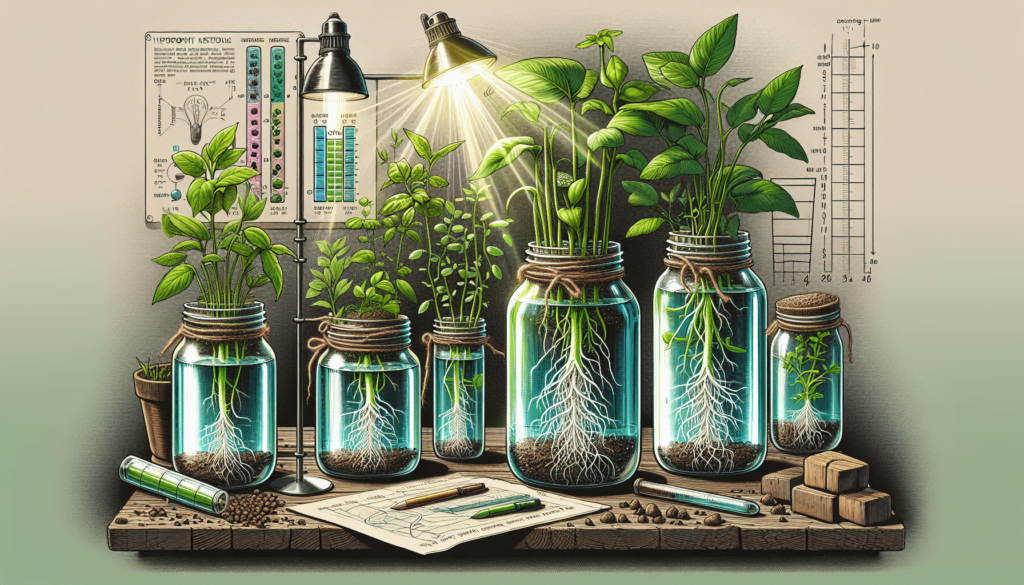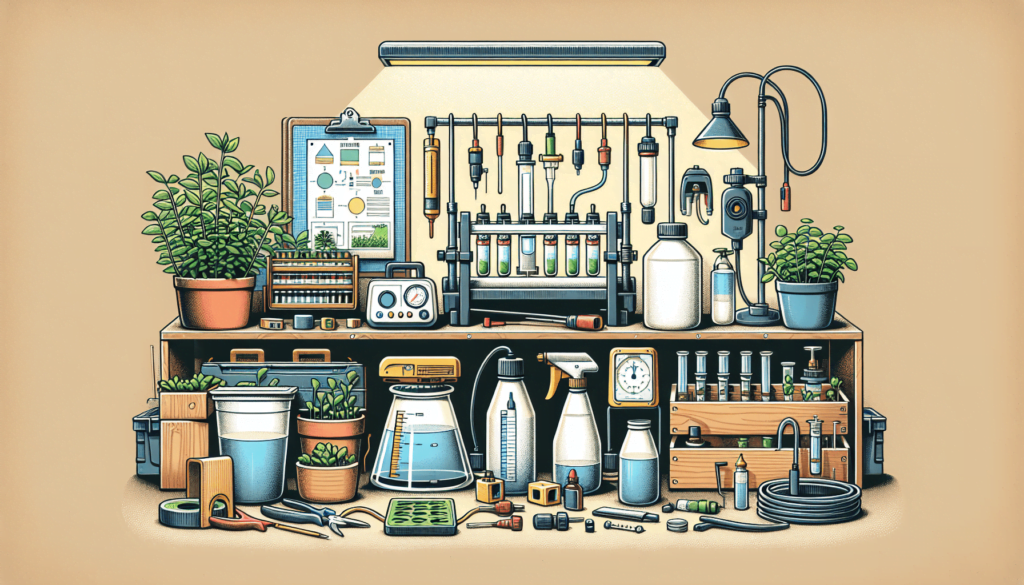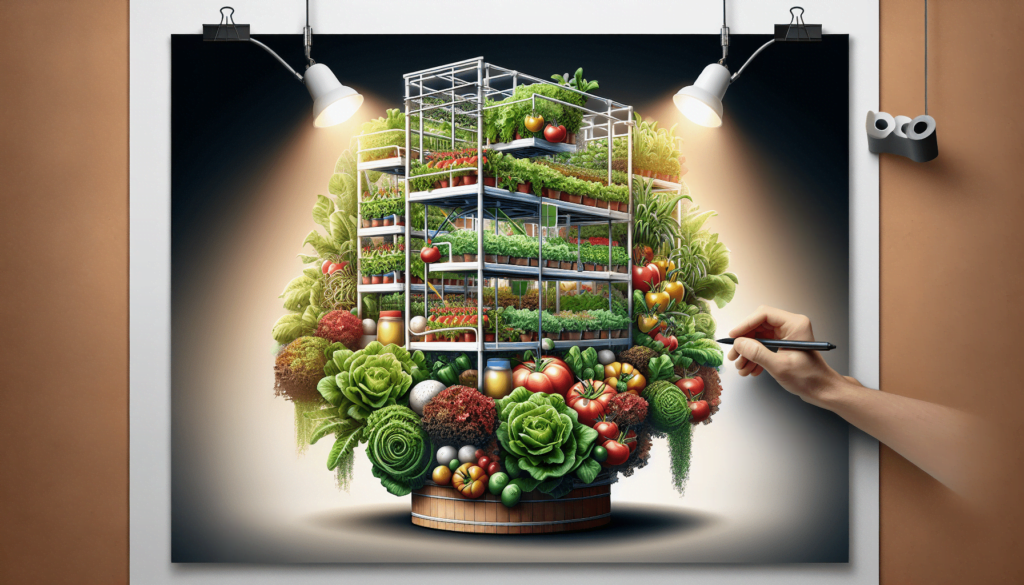Looking for a fun and easy way to bring some greenery into your home? Look no further! Our article on “The Best Plants to Grow in Mason Jars using the Kratky Method” has got you covered. We know that hydroponics can sometimes sound a bit intimidating, but with this method, it’s as simple as setting up your favorite playlist and letting the plants do their thing. Picture this: you, sitting back with a cup of tea, admiring your thriving plants as they grow without the fuss of soil or complex nutrient solutions. Sound enticing? Well, we’ve got all the information you need to get started, from the benefits of hydroponics to the ideal plants to grow in mason jars, using the playful and foolproof Kratky method. So, let’s dig in and discover how you can become a green-thumb guru in no time!
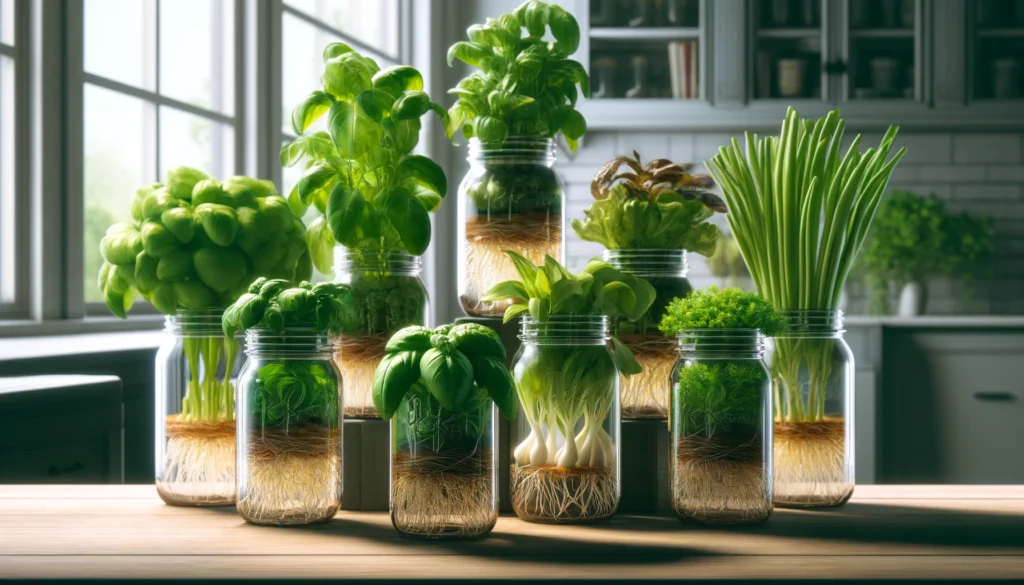
Benefits of Growing Plants in Mason Jars
Sustainability and Recycling
When it comes to sustainable gardening practices, growing plants in mason jars using the Kratky method is a fantastic option. Not only does it allow us to reuse and recycle glass jars that might otherwise end up in the landfill, but it also promotes a more environmentally friendly way of gardening. By using minimal resources and eliminating the need for soil and excessive watering, we can reduce our carbon footprint and contribute to a greener planet.
Versatility and Portability
One of the great advantages of mason jar gardening is its versatility and portability. Whether you live in a small apartment, have limited outdoor space, or simply want a convenient way to grow plants indoors, mason jars provide a flexible solution. With their compact size, you can easily place them on windowsills, countertops, or even hang them from the ceiling with decorative hangers. This portability allows you to move your plants around to catch the optimal amount of sunlight and create a beautiful green oasis wherever you desire.
Enhanced Control and Easy Monitoring
With traditional gardening methods, it can sometimes be challenging to maintain the optimal moisture and nutrient levels for our plants. However, the Kratky method simplifies this process by providing enhanced control and easy monitoring. By filling the mason jar with a precise amount of nutrient-rich water, we can create a self-contained ecosystem that allows the plants to thrive. Additionally, the transparent glass of the jar allows us to monitor the water level, root growth, and overall plant health with ease, ensuring that our green darlings receive the care they need.
Introduction to the Kratky Method
What is the Kratky Method?
The Kratky method, named after its creator, Dr. B.A. Kratky, is a simple and beginner-friendly hydroponic technique that enables us to grow plants in a passive system without the need for electricity, pumps, or constantly monitoring the nutrient solution’s levels. It’s an excellent option for those who are new to hydroponics or have limited resources but still want to enjoy the benefits of soilless gardening.
How Does it Work?
In a nutshell, the Kratky method works by providing a constant supply of nutrient-rich water to the plants while allowing them to grow by absorbing oxygen from the air. It involves filling a mason jar with a specific amount of nutrient solution, suspending the plant’s roots in the solution, and leaving a small air gap at the top to allow for oxygen exchange. As the plants grow, they will naturally consume the water and nutrients, creating a balanced and self-sustaining ecosystem.
Why Choose the Kratky Method for Mason Jar Gardening?
There are several reasons why the Kratky method is an excellent choice for growing plants in mason jars. Firstly, it’s a low-maintenance technique that requires minimal effort. Once the mason jars are set up, you can simply sit back and watch your plants flourish without the need for constant monitoring or adjustments. Additionally, the Kratky method offers an affordable and accessible way for beginners to try their hand at hydroponics without investing in expensive equipment or complex systems. It’s a perfect gateway into the world of soilless gardening.
Ideal Plant Choices for Mason Jar Gardening
Herbs and Spices
Growing herbs and spices in mason jars using the Kratky method is a popular choice among many home gardeners. Basil, mint, thyme, and parsley are just a few examples of herbs that thrive in this setup. Their compact size and ability to flourish in nutrient-rich water make them perfect candidates for mason jar gardening. Imagine having fresh, aromatic herbs right at your fingertips whenever you need them for cooking or garnishing your favorite dishes!
Leafy Greens
Leafy greens are another fantastic option for mason jar gardening. Varieties like lettuce, spinach, and kale can be grown successfully using the Kratky method. These nutrient-dense greens not only add a burst of freshness to your meals but also provide a plethora of health benefits. With a mason jar garden filled with vibrant greens, you can enjoy homegrown salads and stir-fries throughout the year.
Compact Vegetables
Yes, you read that right – you can even grow compact vegetables in mason jars! Miniature varieties of vegetables like cherry tomatoes, mini bell peppers, and baby carrots are perfect for this type of gardening. While they may not yield bumper crops, the joy of plucking and enjoying these delicious homegrown treats is truly rewarding. Plus, they make for an adorable and conversation-starting display in your kitchen or living space.
Best Mason Jar Plants for Beginners
Basil
Ah, basil – the aromatic herb that adds a burst of flavor to countless dishes! If you’re a beginner in mason jar gardening, growing basil is a great way to start. It’s a forgiving plant that thrives in the Kratky method, making it an ideal choice for those new to hydroponics. With its bright green leaves and unmistakable scent, having a mason jar of fresh basil on your kitchen countertop will not only elevate your culinary creations but also provide a delightful visual and aromatic experience.
Lettuce
Imagine having a continuous supply of fresh, crispy lettuce without the hassle of weeding, pests, or summer heatwaves. Well, with mason jar gardening using the Kratky method, that dream can become a reality. Lettuce is known for its fast growth and ability to adapt well to this system. Whether you prefer classic romaine, butterhead, or vibrant leaf lettuce varieties, growing them in mason jars will ensure a constant supply of homegrown goodness for your salads and sandwiches.
Cherry Tomatoes
Who wouldn’t love the taste of juicy cherry tomatoes picked straight from the vine? These sweet and tangy gems are a favorite among gardeners and food enthusiasts alike. With the Kratky method and a mason jar setup, you can easily grow cherry tomato plants indoors or on your balcony. Just imagine plucking those beautiful, sun-ripened tomatoes and adding them to salads, pasta dishes, or simply popping them into your mouth as a healthy snack!
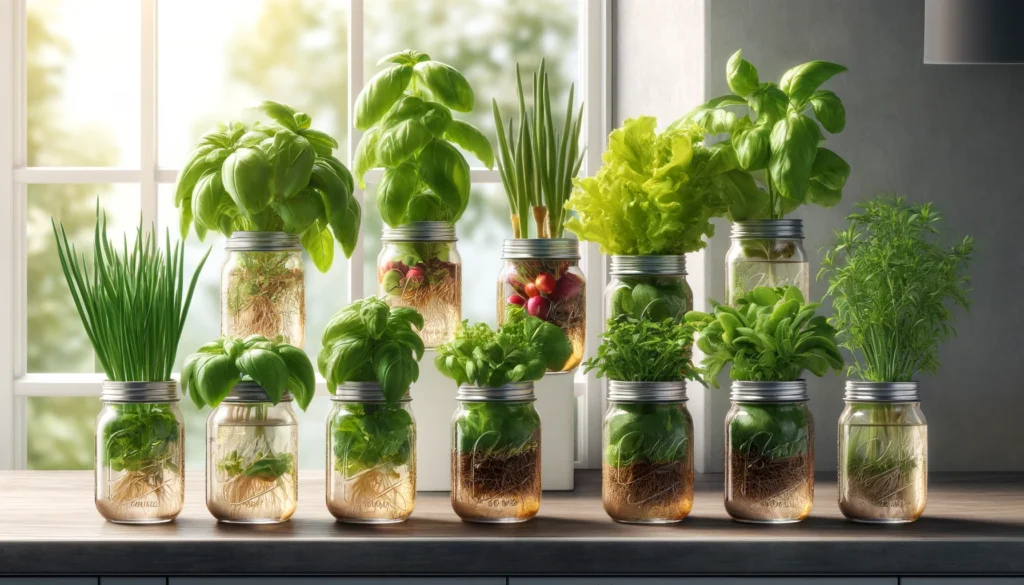
Advanced Mason Jar Plants
Strawberries
If you’re ready to take your mason jar gardening to the next level, why not try growing strawberries? These luscious red fruits are not only a delight to eat but also a joy to grow. While strawberries require a bit more attention and care compared to beginner plants, their sweet reward is well worth the effort. With the proper setup and attentive monitoring, you can enjoy a mini strawberry patch in the comfort of your home.
Bok Choy
Bok choy, with its crisp stalks and tender leaves, is a leafy green that thrives in the Kratky method. This Chinese vegetable is not only delicious but also packed with essential nutrients. Growing bok choy in mason jars allows you to enjoy its fresh crunchiness in stir-fries, soups, or even as a topping for sandwiches. It’s a perfect choice for those looking to expand their mason jar gardening skills and experiment with different flavors.
Bell Peppers
Bell peppers, with their vibrant colors and sweet taste, can be a challenging plant to grow in some climates. However, with the controlled environment provided by mason jar gardening using the Kratky method, you can overcome these challenges and successfully cultivate these versatile vegetables. From green to red, yellow, and even purple, bell peppers come in various colors and add a burst of flavor and visual appeal to countless dishes.
Creative Mason Jar Plant Ideas
Succulents and Cacti
Mason jar gardening is not just limited to edible plants – it’s also a fantastic way to display and care for succulents and cacti. These low-maintenance plants with their unique shapes and textures can create stunning mini gardens in glass jars. From charming individual succulents to creating mini landscapes with a variety of cacti, the possibilities are endless. Imagine having a mason jar filled with a desert oasis on your desk or as a centerpiece on your dining table!
Flowering Plants
Bringing the beauty of nature indoors is made easy with mason jar gardening. Flowering plants like African violets, peace lilies, and orchids thrive in the Kratky method and can be placed in mason jars to create a captivating indoor garden. Not only will these plants add color and fragrance to your living space, but they will also provide a sense of tranquility and joy. Watching these blooms unfurl day by day is a true testament to the wonders of nature.
Air Plants
Air plants, also known as Tillandsias, are unique and fascinating plants that require no soil to thrive. As their name suggests, they absorb moisture and nutrients from the air, making them a perfect match for mason jar gardens. By suspending air plants in glass jars, you can create eye-catching displays that defy gravity and captivate the imagination. These low-maintenance plants will delight you with their peculiar beauty and serve as conversation pieces in your home.
Choosing the Right Mason Jar and Setup
Size and Shape Considerations
When it comes to choosing the right mason jar for your gardening endeavor, size and shape considerations are essential. Smaller mason jars, such as half-pint or pint sizes, are suitable for growing herbs, spices, and compact vegetables. They take up less space and are easier to handle and maintain. For larger plants like tomatoes or strawberries, quart-sized jars provide ample room for root growth. As for the shape, standard wide-mouth mason jars are generally preferred, as they offer easier access to the plants and allow for better air circulation.
Filling and Nutrient Measurements
To ensure the optimal growth of your plants, it’s crucial to get the filling and nutrient measurements right. The general rule of thumb is to leave about one to two inches of air gap between the top of the water and the rim of the mason jar to allow for oxygen exchange. As for the nutrient solution, it’s recommended to follow the instructions provided with the hydroponic nutrients you’re using. Each nutrient may have different ratios and measurements, and it’s vital to provide the right balance to support healthy plant growth.
Light and Temperature Requirements
Plants, whether grown in mason jars or in traditional soil gardens, require proper light and temperature conditions to thrive. Most plants, including those grown using the Kratky method, require a minimum of 6-8 hours of sunlight per day. If natural sunlight is limited, you can supplement it with artificial grow lights. Additionally, it’s important to consider the temperature requirements of the plants you’re growing. Most herbs, leafy greens, and vegetables prefer temperatures between 60-75°F (15-24°C), making them suitable for indoor cultivation.
Maintenance Tips for Mason Jar Gardens
Monitoring Nutrient Levels
Regularly monitoring and maintaining optimal nutrient levels is vital for the success of your mason jar garden. As the plants consume the water and nutrients, it’s necessary to replenish the nutrient solution accordingly. Keep an eye on the water level, making sure it doesn’t fall below the recommended gap between the top of the water and the jar rim. Additionally, check the pH levels of the nutrient solution periodically and adjust as needed to ensure nutrient availability and absorption by the plants.
Pruning and Trimming
Like any garden, mason jar gardens require occasional pruning and trimming to keep the plants healthy and promote growth. Remove any yellowing or dead leaves to prevent the spread of diseases and allow the plants to focus their energy on producing vibrant new growth. For herbs, regular pruning will encourage bushier growth and ensure a continuous supply of fresh leaves. Pay attention to the individual requirements of each plant and adjust your pruning routine accordingly.
Troubleshooting Common Issues
Even the most experienced gardeners encounter challenges and issues at times, and mason jar gardening is no exception. Common issues like algae growth, pests, or root rot can occur, but with a little bit of troubleshooting, they can be overcome. To prevent algae growth, ensure that your mason jars are not exposed to direct sunlight, or cover them with an opaque material. For pest control, inspect the plants regularly and remove any insects manually. If root rot becomes a problem, try adjusting the water level or adding a small air stone to improve oxygenation.
Decorative Enhancements for Mason Jar Gardens
Painting and Etching Techniques
While mason jars themselves are charming, there are many ways to enhance their appearance and make them truly stand out. Painting and etching techniques allow you to personalize your mason jars and create stunning works of art. You can experiment with different colors, patterns, or even create unique designs that reflect your personality and style. Not only will these decorative enhancements transform your mason jar garden into a visual masterpiece, but they will also add a touch of individuality to your home decor.
DIY Plant Stands and Hangers
To take your mason jar garden to new heights – literally – consider creating DIY plant stands or hangers to showcase your plants. Using materials like wood, rope, or metal, you can design and build customized stands or hang your mason jars from various heights. These plant stands and hangers not only provide additional support and stability for your plants but also create an eye-catching display. Get creative and let your imagination run wild as you design the perfect structure to showcase your green beauties.
Incorporating Mason Jar Gardens into Home Decor
Mason jar gardens aren’t just pleasing to the eye – they can also be seamlessly integrated into your overall home decor. By strategically placing your mason jars in various rooms, you can create a cohesive and harmonious aesthetic. For instance, a collection of herb-filled mason jars on a kitchen windowsill not only adds a fresh and vibrant touch to the space but also provides easy access to herbs while cooking. Similarly, hanging mason jar gardens in your living room or office can bring nature indoors and create a calming and inviting atmosphere.
Conclusion and Next Steps
Congratulations! You have now embarked on an exciting journey of mason jar gardening using the Kratky method. By exploring the benefits, ideal plant choices, maintenance tips, and creative ideas, you have gained valuable insights into this innovative gardening technique. Now, it’s time to put your newfound knowledge to use and start growing your own mason jar garden.
Don’t be afraid to experiment with different plants and expand your gardening horizons. Perhaps try growing strawberries or bell peppers for an advanced challenge, or go for the simplicity of basil and lettuce if you’re just starting out. Remember to monitor your plants’ nutrient levels, prune and trim as needed, and troubleshoot any issues that may arise along the way.
As you embark on this journey, consider sharing your mason jar garden success with others. Whether through social media, online gardening communities, or even hosting a garden party, spreading the joy and inspiration of mason jar gardening can create a sense of camaraderie and forge new connections with fellow green thumbs.
Lastly, keep in mind that mason jar gardening is a continuous process of learning and exploration. Stay curious, ask questions, and never stop experimenting with different plants and setups. Together, we can grow a flourishing community of mason jar gardeners who embrace the beauty and sustainability of this unique gardening practice. Happy gardening!
Forum
Got something to share or a question to ask? Jump in and start a conversation! Whether it’s tips, advice, or just sharing your experiences, we’d love to hear from you. Don’t be shy—your input could inspire or help someone else!- This forum has 1 topic, and was last updated 10 months, 1 week ago by .
- Topic
- Voices
- Last Post
- You must be logged in to create new topics.
Register Here
Forum
Got something to share or a question to ask? Jump in and start a conversation! Whether it’s tips, advice, or just sharing your experiences, we’d love to hear from you. Don’t be shy—your input could inspire or help someone else!- This forum has 1 topic, and was last updated 10 months, 1 week ago by .
- Topic
- Voices
- Last Post
- You must be logged in to create new topics.
